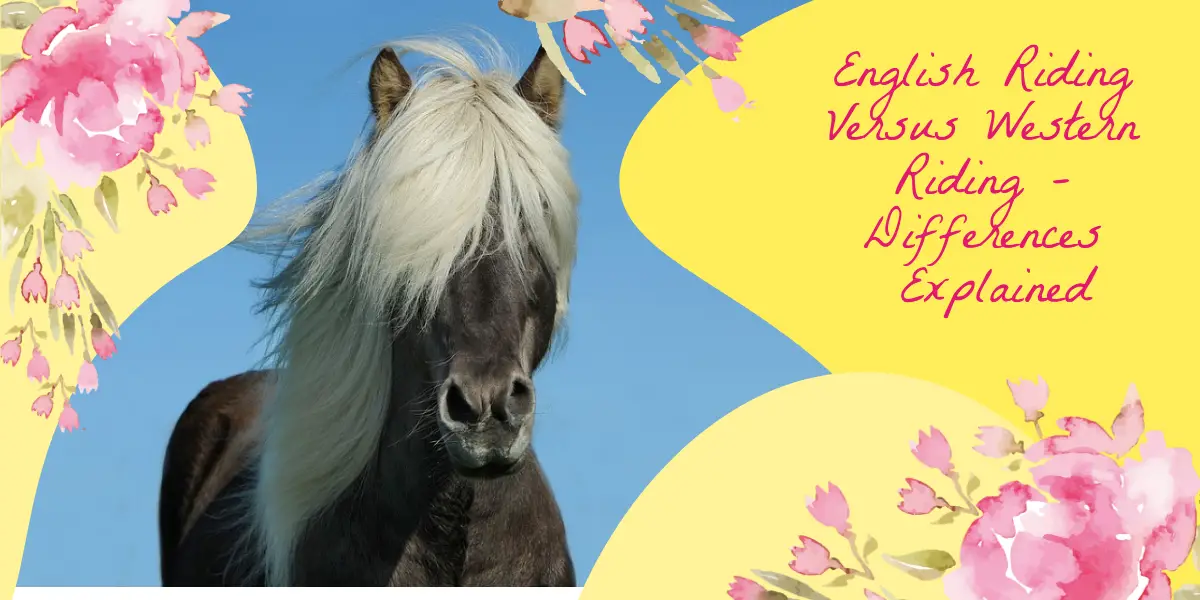English Riding Versus Western Riding – Differences Explained

Horse riding, a royal sport, is a good combo of adventure and exercise. The more you go for a ride, the more addicted you become to it, because of the adventure in it and its closeness to nature. Imagine riding in the misty morning on the seashell-white mountain; the greenish grass is wet and lush; birds are chanting, and your soul gets inspired by the musical beauty in god’s creation.
You must be wondering to get up and go for a ride, aren’t you?
As a dose of logical reasoning, it is good to be aware of the types of horse riding.
There are mainly two main types of Horse riding – Western and English Riding.
In the lines below, we will discuss some of the contrasting properties of the two so that you will have a clearer picture of the two.
Saddle
Western Saddle
On the outlook to an untrained eye, they both may look similar. It was designed and developed to help ranchers and herders to spend long spans of time on horsebacks without minimal trouble. But a western saddle has the following characteristics that make it distinguishable from the English one:
• A deeper seat for comfort especially to the legs.
• A horn to hold on to on sharp turns. Also, it can be used to rope cattle.
• Even weight distribution throughout the horse’s back. This results in more stability and maneuverability.
It may vary in size and purpose but a general western saddle has all the attributes listed in the above lines.
English Saddle
When compared to its western counterpart, it is much lighter and conventional with a stripped-down design. It is interesting to note that the original English saddle was much similar to the western one which is still used by the Spanish Riding School in Vienna. Still, today’s English Saddle’s history is not tricky and can be traced back to the 1800s.
During that time, hunts were very popular among the riders – the notorious fox hunts. It was wildly pursued in England and Ireland which meant that riders needed a lighter and comfortable while speeding and fencing. Riders would lean back when they jumped over the fences which required the saddle to have a depressed cantle. The time was ripe to give both the riders and horse an edge against the work they needed to do.
Bridles
There is not much difference between the bridles used in both schools of riding. The one minor discrepancy is that;
• In Western-style riding, a curb or leverage is employed by the riders.
• In the same fashion, a snaffle is employed by the riders in English riding style.
Other than that, the bridles are the same in both riding schools.
Reins
Again, this is one of the aspects in both schools of riding where you will find both closed and split reins. On average, western riders use more split reins. In a comparison with closed reigns, there are two advantages when you use split reins.
• They are longer and offer more versatility.
• There are almost no chances that your horse will get tangled in the reins.
• You do not have to get the reigns over the head of the horse.
There are ways through which you can make split reigns into a closed one, using a buckle.
Reins are more on the side of personal preference and choice. There are riders in both Western and English schools who would prefer one over the other. Both offer control and stability to the riders so there is not much divergence here.
Clothing
Clothing and apparel are important on a competitive level. For the everyday ride, you can always wear whatever you want, as long it is suitable for horse riding. When you reach the competitive level, there are differences between Western riding and English riding clothing that you need to follow.
In this day and age, shows and competitions have their own rules and guidelines which contestants will have to follow. Following are some general rules of both Western school and English school.
Western School
• In a conventional Western riding competition, you need to wear a Western hat, or you can opt for a riding helmet for enhanced safety and comfort. The choice is mostly yours.
• Over the shirt, women can wear a scarf or a necklace. Bolo ties are worn by men during Western competitions mostly.
• Riders wear show pants or jeans with belts and buckles which can be plain or jeweled depending on personal taste or directions by the committee.
• Western boots are a must if you need to compete in a Western riding competition.
• Spurs are not allowed and wearing them could result in the immediate elimination of a contestant.
Read more about Riding
